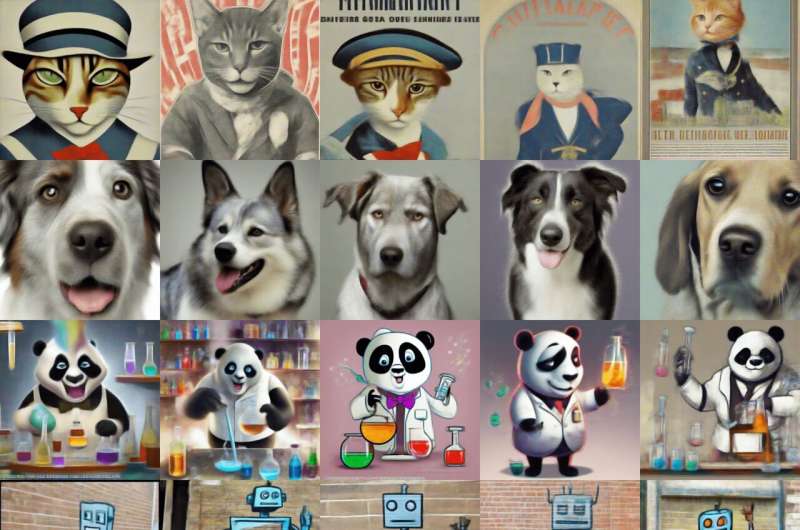This article has been reviewed according to Science X's editorial process and policies. Editors have highlighted the following attributes while ensuring the content's credibility:
fact-checked
preprint
proofread
AI trained to draw inspiration from images, not copy them

Powerful new artificial intelligence models sometimes, quite famously, get things wrong—whether hallucinating false information or memorizing others' work and offering it up as their own. To address the latter, researchers led by a team at The University of Texas at Austin have developed a framework to train AI models on images corrupted beyond recognition.
DALL-E, Midjourney and Stable Diffusion are among the text-to-image diffusion generative AI models that can turn arbitrary user text into highly realistic images. All three are now facing lawsuits from artists who allege generated samples replicate their work. Trained on billions of image-text pairs that are not publicly available, the models are capable of generating high-quality imagery from textual prompts but may draw on copyrighted images that they then replicate.
The newly proposed framework, called Ambient Diffusion, gets around this problem by training diffusion models through access only to corrupted image-based data. Early efforts suggest the framework is able to continue to generate high-quality samples without ever seeing anything that's recognizable as the original source images.
Ambient Diffusion was originally presented at NeurIPS, a machine-learning conference, in 2023 and has since been adapted and extended. The follow-up paper, "Consistent Diffusion Meets Tweedie," available on the arXiv preprint server, was accepted to the 2024 International Conference on Machine Learning. In collaboration with Constantinos Daskalakis of the Massachusetts Institute of Technology, the team extended the framework to train diffusion models on data sets of images corrupted by other types of noise, rather than by simply masking pixels, and on larger data sets.
"The framework could prove useful for scientific and medical applications, too," said Adam Klivans, a professor of computer science, who was involved in the work. "That would be true for basically any research where it is expensive or impossible to have a full set of uncorrupted data, from black hole imaging to certain types of MRI scans."
Klivans; Alex Dimakis, a professor of electrical and computer engineering; and other collaborators in the multi-institution Institute for Foundations of Machine Learning directed by the two UT faculty members experimented first by training a diffusion model on a set of 3,000 images of celebrities, then using that model to generate new samples.
In the experiment, the diffusion model trained on clean data blatantly copied the training examples. But when researchers corrupted the training data, randomly masking up to 90% of individual pixels in an image, and retrained the model with their new approach, the generated samples remained high quality but looked very different. The model can still generate human faces, but the generated ones are sufficiently different from the training images.
"Our framework allows for controlling the trade-off between memorization and performance," said Giannis Daras, a computer science graduate student who led the work. "As the level of corruption encountered during training increases, the memorization of the training set decreases."
The researchers said this points to a solution that, though it may change performance, will never output noise. The framework offers an example of how academic researchers are advancing artificial intelligence to meet societal needs, a key theme this year at The University of Texas at Austin, which has declared 2024 the "Year of AI."
The research team included members from the University of California, Berkeley and MIT.
More information: Giannis Daras et al, Consistent Diffusion Meets Tweedie: Training Exact Ambient Diffusion Models with Noisy Data, arXiv (2024). DOI: 10.48550/arxiv.2404.10177


















